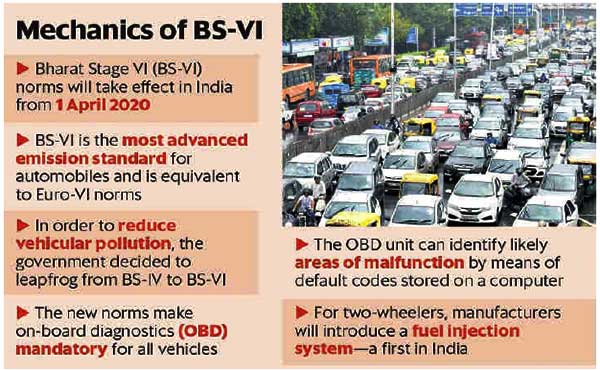BS-VI Emission standards
2020 MAR 30
Mains >
Industry and infrastructure > Industrial Policies > Air pollution

Why in news:
In a bid to bring down pollution levels, the Central government has announced that from April 1, 2020, all vehicles sold in India should comply with Bharat Stage-VI, or BS-VI emission standards.
Bharat Stage:
- The Bharat Stage emission standards are legal limits on the amount of air pollutants that a compression ignition or spark-ignition vehicle in India can emit.
- The standards, based on European emission standards (Euro I, II, III etc.) were first introduced in 2000.
- They are set by the Central Pollution Control Board under the Ministry of Environment and Climate Change.
- Prior to the 1990s, Leaded petrol was used in vehicles to help reduce engine knocking, and the wear and tear. But their use posed serious health and environmental concerns.
- Following a landmark Supreme Court order in April 1999, the Centre notified Bharat Stage-I and Bharat Stage-II norms, broadly equivalent to Euro I and Euro II respectively. BS-II was for the National Capital Region and other metros; BS-I for the rest of India.
- From April 2005, BS-III and BS-II fuel quality norms came into existence for 13 major cities, and for the rest of the country respectively.
- From April 2010, BS-IV and BS-III norms were put in place in 13 major cities and the rest of India respectively.
- BS-V and BS-VI norms were to be implemented from April 1, 2022, and April 1, 2024 respectively. But in 2016, the government announced that the country would skip the BS V norms altogether and adopt BS VI norms by 2020.
- Features
- The Sulphur content in BS6 fuel is five times lower (10ppm) as compared to sulphur content in BS4 fuel (50ppm).
- The nitrogen oxide level for the BS6 diesel engine and petrol engine will be brought down by 70% and 25% against BS IV norms.
- BS VI standards require reductions in tailpipe emissions of nitrogen oxides (NOx) and particulate matter (PM). Hence, engine manufacturers will have to use diesel particulate filter (DPF) and selective catalytic reduction (SCR) system.
- Real Driving Emission (RDE) and Onboard Diagnostics (OD) will be implemented to measure a vehicle’s pollutant emission in real-time conditions. It was not part of the BS4 emission norms.
|
Feature
|
BS IV (mg/km)
|
BS VI (mg/km)
|
|
Nitrous oxide (NOx)
|
Petrol
|
80
|
60
|
|
Diesel
|
250
|
80
|
|
Particulate Matter
|
Petrol
|
-
|
< 4.5
|
|
Diesel
|
25
|
< 4.5
|
|
Sulphur
|
|
50 ppm
|
10 ppm
|
Benefits of BS-VI norms:
- Environmental benefits: The dramatic reduction in the permissible Sulphur, nitrogen and particulate matter levels can help address the issue of poor air quality faced by several cities in India.
- Quality fuel: All fuel stations in the nation will upgrade to BS VI compliant fuel by 1 April. Indian refineries are investing 30,000 crore rupees to upgrade the technology. This way, India will join the select league of nations using petrol and diesel containing just 10 ppm of Sulphur and emission standards are as good as CNG.
- Added investments: By acquiring technologies and capabilities necessary for BS VI compliance through joint ventures, home-grown companies have a chance to move up the value chain. For multinationals, it offers a chance to invest in India’s booming economy.
- Future proofing: BS VI fuel has less Sulphur content which acts as lubricant in BS-IV vehicles, thus causes issues to the fuel injector over the long run. Hence, the switch to BS VI will force the owners to discard their old highly polluting diesel vehicles to cleaner engines.
Challenges:
- Rise in production cost: The shift from BS-IV to BS-VI compliance in less than a year has forced India’s automotive sector into making significant investments into developing new technologies and upgrading the production plants, which has pushed up the cost of production.
- Potential loss: In all previous instances, manufacturers were allowed to exhaust their stock of older generation inventory after the onset of new emission standards. However, now they are given a sales bound deadline to sell their BS IV units. This has forced them to sell off units at reduced prices, which has affected their profitability.
- Increase in fuel prices: Oil refiners have invested heavily to upgrade their refineries to produce the cleaner BS-VI compliant fuel. This price rise will be offset by increasing the distribution price of fuel.
- Presence of older models: No deadlines have been set to phase out the older generation BS VI and III vehicles. Their presence limits the potential environmental benefits
Way forward:
- The government should also look into adopting a targeted phasing out of the existing fleet of BS IV And III vehicles and substituting them with electric vehicles.
- Seeing the poor air quality levels in Indian cities, the early implementation of BS 6 across India is a welcome step. However, this alone is not going to solve the issue of air pollution in India.
- There should be efforts to restructure the urban landscape of India. An integrated public transport system, promotion of electric mobility and improved green cover can help bring down pollution footprints of urban areas. Hence, a comprehensive transport policy and urban development models are essential in this regard.
Practice Question
Q. The Central government has announced that from April 1, 2020, all vehicles sold in India should comply with BS-VI standards. What is Bharat Stage Emission standards? Discuss the benefits of switching to BS VI?
